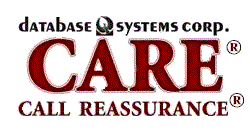|
|


Answering Machine Detection
 CARE (Call Reassurance) is a calling phone system used by a number of police departments and sheriff's offices as well as community volunteer organizations.
CARE (Call Reassurance) is a calling phone system used by a number of police departments and sheriff's offices as well as community volunteer organizations.
This program was developed by Database Systems Corp. (DSC) and calls seniors and residents who are living at home alone to check on their well-being.
By answering the automated call and pressing the "I'm OK" phone key, the resident acknowledges that they are OK.
The CARE phone system must at times determine whether the call was answered by the CARE subscriber or by an answering machine.
DSC utilizes the answering machine detection feature within the voice broadcasting phone system telephony boards to accomplish this task.
What Is Answer Machine Detection?
"Answer machine detection is a combination of computer hardware and software that analyses the greeting from a phone caller. This technology determines whether the message was from a "live" person or generated by an answer machine. By dissecting the quality and tone of this message, computer technology can accurately determine the difference approximately 80-95% of the time." - source: Intel D41 board specifications
When the CARE phone system calls a senior or home alone child, it can determine whether the answered call was by an individual or answering machine based upon the signals received from the internal Intel telephony board. CARE responds differently to each type of response.
Contact DSC to learn more about CARE phone systems and phone services.
CARE Answer Machine Detection
Calls are made by our automated CARE phone system and provides telephone reassurance by playing a greeting message as well as a menu that allows the CARE subscribers to acknowledge they are OK.
Likewise call reminders can be sent to senior to remind them to take their medications.
CARE employs different logic for each type of call with respect to answer machine detection.
Telephone Reassurance
Because answer machine detection is not 100% reliable, CARE uses a fail-safe method when making telephone reassurance calls to seniors and home alone kids. This positively ensures that a CARE alert is generated when a senior or child does not respond, yet minimizes multiple calls to a CARE subscriber who is OK.
 Because CARE (by default) requires a positive acknowledgement from the CARE subscriber (who must push the "I'm OK" phone key), CARE can not designate that a senior is OK when in fact the senior was not OK.
Because CARE (by default) requires a positive acknowledgement from the CARE subscriber (who must push the "I'm OK" phone key), CARE can not designate that a senior is OK when in fact the senior was not OK.
If the CARE system detects an answer machine when in fact a "live" person answers the call, CARE still plays a greeting message and waits for the "I'm OK" phone key response. This eliminates duplicate phone calls to seniors because they still can say they are OK, even though CARE thinks it is communicating with an answer machine.
If no response is received, CARE assumes that an answering machine responded to the call and queues the call for another retry based upon the subscriber's profile configuration. After several retries and no response, a CARE alert is generated.
Call Reminders
 When sending call reminders, CARE first determines if the answered call was by a "live" person or by an answering machine. If the phone system informs the CARE software that this is a live person, CARE immediately plays the recorded reminder message.
When sending call reminders, CARE first determines if the answered call was by a "live" person or by an answering machine. If the phone system informs the CARE software that this is a live person, CARE immediately plays the recorded reminder message.
If the CARE phone system determines that an answering machine greeting was detected, it waits until the end of the greeting and then plays the recorded reminder message.
In either case, the message is delivered to the CARE subscriber, with only a slight variation in delivery time if an answer machine is falsely detected.
CARE Information
Contact DSC to learn more about our CARE call reassurance services and phone systems.
|
|



 CARE (Call Reassurance) is a calling phone system used by a number of police departments and sheriff's offices as well as community volunteer organizations.
CARE (Call Reassurance) is a calling phone system used by a number of police departments and sheriff's offices as well as community volunteer organizations.
 Because CARE (by default) requires a positive acknowledgement from the CARE subscriber (who must push the "I'm OK" phone key), CARE can not designate that a senior is OK when in fact the senior was not OK.
Because CARE (by default) requires a positive acknowledgement from the CARE subscriber (who must push the "I'm OK" phone key), CARE can not designate that a senior is OK when in fact the senior was not OK.
 When sending call reminders, CARE first determines if the answered call was by a "live" person or by an answering machine. If the phone system informs the CARE software that this is a live person, CARE immediately plays the recorded reminder message.
When sending call reminders, CARE first determines if the answered call was by a "live" person or by an answering machine. If the phone system informs the CARE software that this is a live person, CARE immediately plays the recorded reminder message.